Union Pacific Railroad CFO Talks About Supporting Women Workers
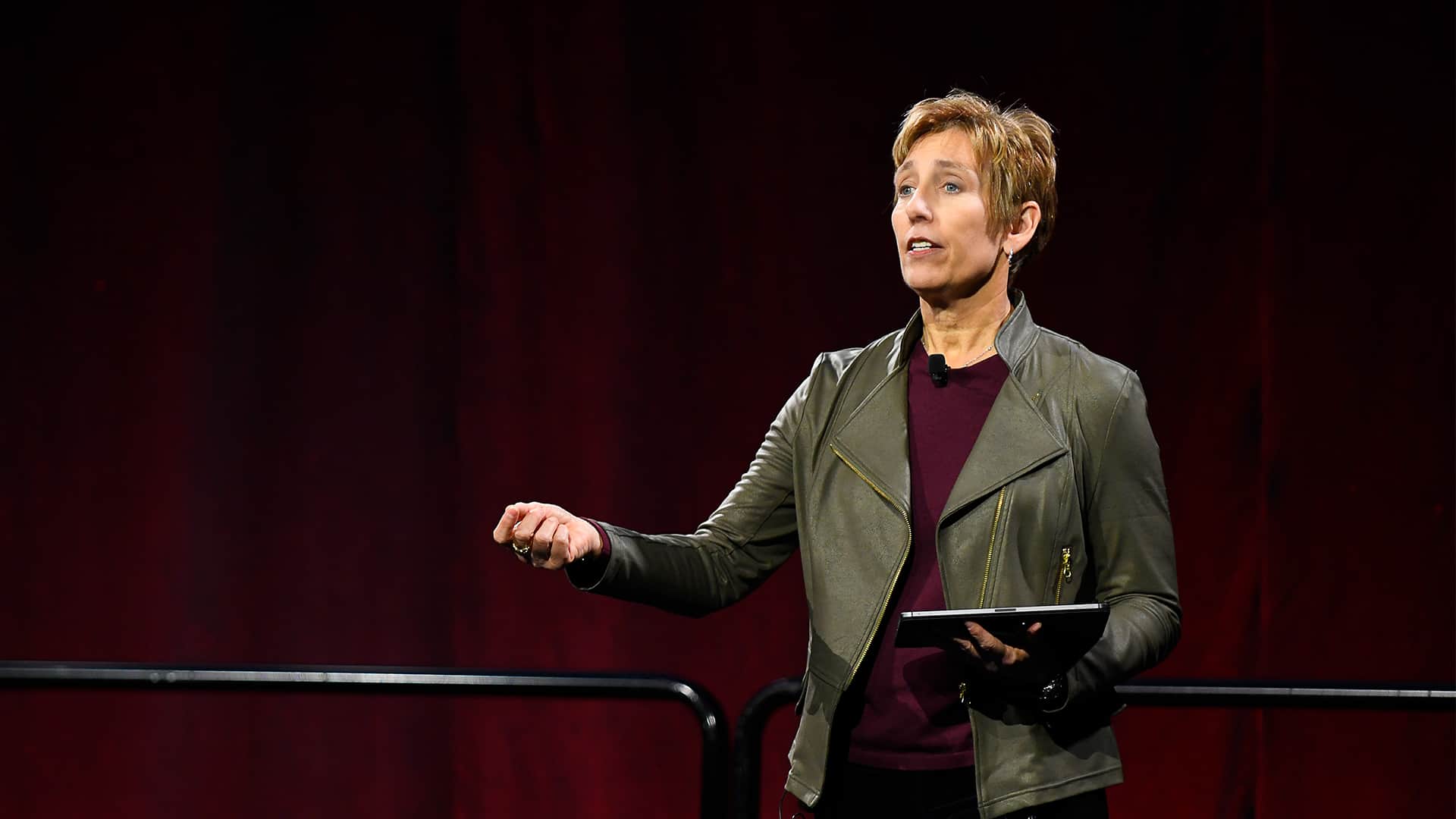
When Jennifer Hamann went to college, she intended to be a fashion merchandising major—but she soon realized that it wasn’t for her.
“At the time, fashion merchandising was a combination of business and home economics,” said Hamann. “When I found out I had to sew, I dropped out.”
Instead, she pivoted to finance, which set her on the path to her current position as executive vice president and chief financial officer at Union Pacific Railroad. She was recently honored by the Manufacturing Institute—the NAM’s 501(c)(3) workforce development and education affiliate—with a Women MAKE Award, recognizing outstanding women working in the manufacturing industry.
A flexible career: When Hamann reflects on her time at Union Pacific, she sees flexibility and a willingness to try new things as a consistent theme—as when she shifted from a position on the audit staff to a role in human resources.
- “The thing that I think is a great selling point about Union Pacific is that you can still get your paycheck from the same company, but you can make wholesale career changes over the course of your career,” said Hamann.
- “I’ve done that. … I’ve taken on roles that were totally different than what I had gone to school for, or what I started doing when I came to Union Pacific. And I think that’s a real benefit to businesses like ours.”
Serving with pride: According to Hamann, the 161-year-old company’s workforce takes a great deal of pride in what they do and prioritizes a team-centered environment.
- “There’s tremendous pride in the workforce,” said Hamann. “Our tagline is Building America, and that really is how we think of ourselves. Supporting so many parts of America’s economy and so many communities—that pride is a big deal.”
Pushing for diversity: Hamann was previously president and now serves as the executive adviser of Union Pacific’s employee resource group for women called LEAD (which stands for Lead, Educate, Achieve and Develop). The ERG is one of nine at the railroad that helps foster inclusion and cultural awareness by creating networks that develop Union Pacific’s workforce and its culture.
- “One of the focus areas we’ve had as a [LEAD] group over the last several years is really reaching out into our field locations,” said Hamann. “If women can see other women in some of those roles that have been traditionally held by men, that helps give them greater confidence, and it helps in our overall recruiting and retention efforts to bring people into those jobs.”
Building a future: Hamann is proud of the work Union Pacific is doing to attract a diverse workforce, including by offering free college tuition for employees and by stressing pay equity and retention.
- “Not only do I think Union Pacific is a great place to work, but we really want it to be a great place for more women going forward,” said Hamann. “When I think about the future, I’d love to see it be a future where the demographics of Union Pacific reflect the demographics of the country and the communities where we operate.”
The last word: “This is a company with a very supportive culture,” said Hamann. “We value diversity, equity and inclusion. We want people to succeed. We have opportunities to build your network. Give us a try and see what you think.”
More reading: View the full list of this year’s Women MAKE Award Honorees and Emerging Leaders here, and learn more here about the Women MAKE Mentorship Program to help inspire the next generation of female talent.
“The Best Thing I Ever Did”: Creators Wanted Stops in Louisiana
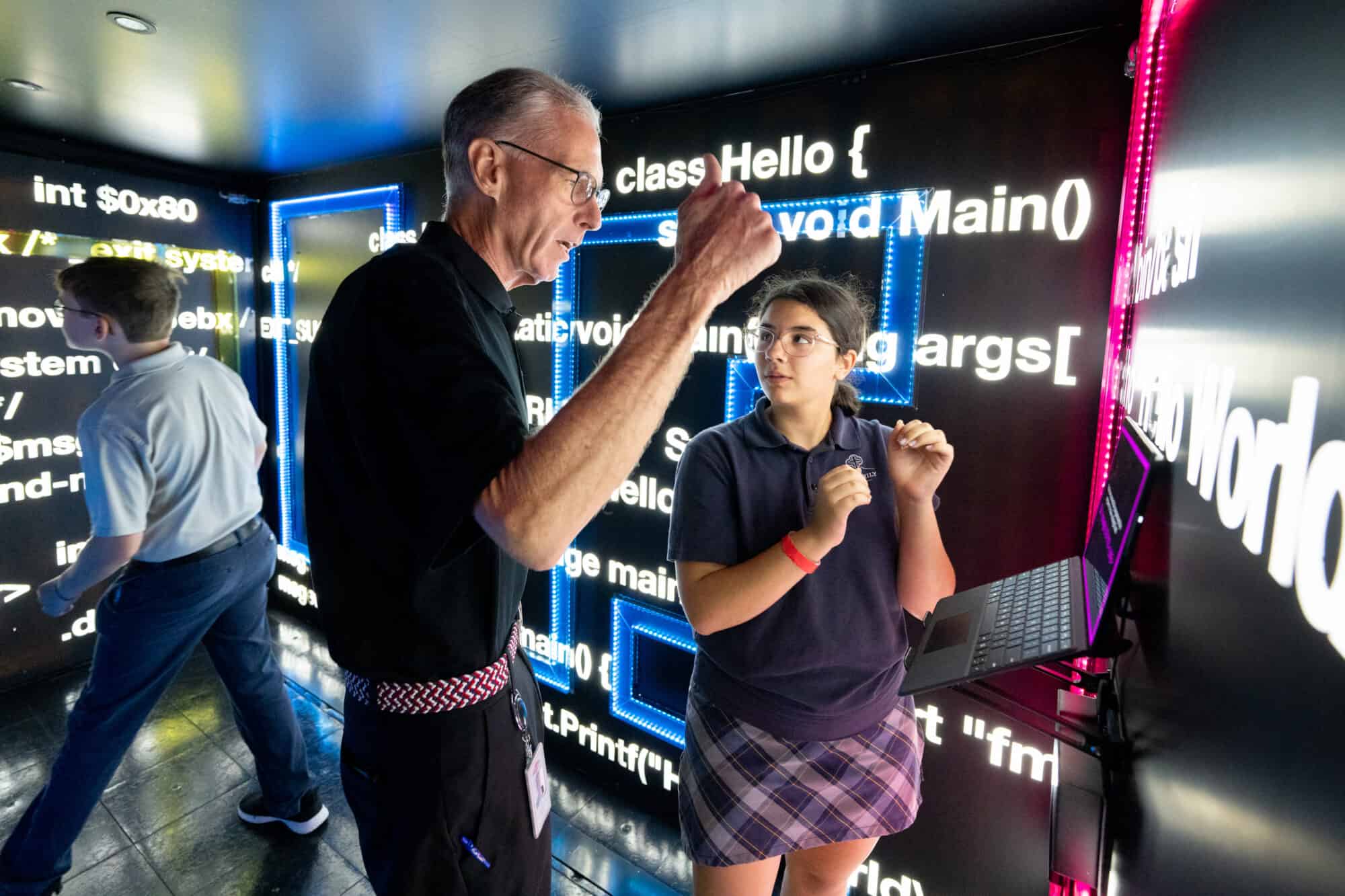
It was the 14th stop of the Creators Wanted Tour, but the level of enthusiasm among attendees made it seem like the first.
What happened: This week’s visit of the award-winning mobile immersive experience—an initiative of the NAM and its 501(c)3 workforce development and education affiliate, the Manufacturing Institute—to the Baton Rouge, Louisiana, area was an unequivocal hit.
- Hosted by Dow with the participation of Union Pacific, the Louisiana Association of Business and Industry, FactoryFix, River Parishes Community College and BASF, the event drew more than 500 students to the college’s Westside Campus in Plaquemine, Louisiana. Students came from the college as well as area middle and high schools.
- The digital campaign signed up more than 26,000 new students and career mentors in Louisiana to learn more about modern manufacturing. In addition, Dow (a third-time Creators Wanted host) and Union Pacific had team members on-site to answer students’ questions about their careers.
High tech: Dow displayed drones and robots—including one named Spot—to give students a peek at some of the cutting-edge technologies they might expect to work with in manufacturing. Meanwhile, Union Pacific offered 3D virtual tours of company operations.
Manufacturing is everywhere: River Parishes Community College Chancellor Quintin D. Taylor, who gave opening remarks at the kickoff event, emphasized the extent to which manufacturing touches everyone each day—and how fulfilling a career in it can be.
- “Even the toothpaste we all used this morning was made in a facility that does manufacturing,” Taylor said. “Should a time come in your life where you decide to have a family, you have to be gainfully employed to take care of your family. Manufacturing is just one of many careers, quite frankly, that can help you do that.”
“Be somebody big”: Union Pacific Executive Vice President of Marketing and Sales Kenny Rocker seconded that sentiment.
- “Who wants to make the world better and make a lot of money doing it?” Rocker asked the audience to a show of numerous hands. With a manufacturing career, “you can be the GOAT in your family,” he continued, referring to the acronym meaning “Greatest of All Time.” “You can be somebody big in your family.”
- Stay tuned: Union Pacific will host a Creators Wanted stop in the Minneapolis–St. Paul area in the fall.
Creators required: There’s an acute need for more workers in manufacturing, MI President and Executive Director Carolyn Lee said, and there’s something in it for everyone.
- “I can promise you if you are interested in designing, building, solving, creating things, fixing things with your hands, just figuring stuff out, there is a home for you in manufacturing,” she said.
- Lee cited research by the MI and Deloitte that found if current trends continue, manufacturers will need to fill some 4 million jobs by the end of this decade.
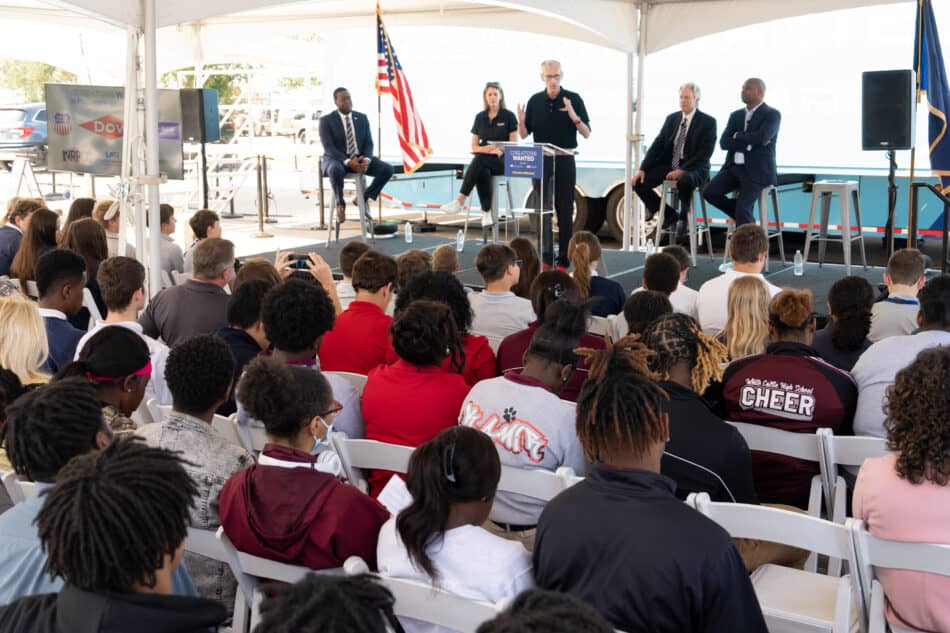
Autograph-worthy: Attendees were so inspired by the kickoff-event remarks of Dow Chairman and CEO (and NAM Board Chair) Jim Fitterling—who spoke about students’ opportunities to do something historic in their careers—that several requested his autograph.
- “The world’s going through one of the biggest changes since we industrialized the United States,” said Fitterling, who along with NAM President and CEO Jay Timmons wrote an op-ed about the tour that appeared in the Louisiana Policy Review this week.
- “We’re about to go through another … massive change because we’re going to reindustrialize this country. And that means you are going to get to work on some of the biggest projects that we have ever seen in the world.”
- Fitterling, who personally took students through the Creators Wanted immersive experience before his talk, emphasized, “We’re here to see you. We’re interested in you. We want you to have a great future, and we want you to have … opportunities.”
“I’m still having fun”: Panel discussions featured leaders and team members from Dow as well as Turner Industries, giving students a more in-depth perspective about modern manufacturing careers.
- During an on-stage discussion with Fitterling, Dow Senior Lead Site Manufacturing Director Crystal King told the audience how she came to choose engineering: her mother chose it for her.
- “When I was in 10th grade, my mom asked me what did I want to do,” King said. She had said she wanted to go into education because her mother was a teacher. Then her mother “explained that when she went to college, there were only two things that, as an African-American female, she could be. One was a teacher, and one was a nurse. And I needed to do something other than either one of the two of them.”
- Despite thinking she “would hate” being an engineer, King loved it—and she still loves it. “This is the best job in the world,” she told the audience. “I tease Jim [Fitterling]—I say, ‘When I stop having fun, I’m going home.’ I’m still having fun.”
The reception: In addition to a student who was “left … speechless” by the week’s events and another who called Creators Wanted “the best thing I ever did,” the tour stop had social media abuzz with praise for the initiative:
- “Thank you to #CreatorsWanted for hosting our students over the past two days,” tweeted White Castle High School. “The students had a great time learning and building excitement about modern manufacturing careers.”
- “Our Juniors and Seniors are having a fantastic time at #creatorswanted today!” tweeted Plaquemine High School. “They’re expanding their knowledge of the manufacturing industry and workforce, while also getting a chance to tour RPCC. A big thank you to #Creatorswanted, Dow and RPCC for this opportunity!”
Coming up: Creators Wanted will travel to Marysville and Columbus, Ohio, next week for stops at the Honda Heritage Center and the COSI Science Festival, sponsored by Honda. Later in May, the tour goes to the Indy 500 in Indianapolis.
Creators Wanted in action: See here, here and here for exciting footage of this week’s tour stop, including the remarks of LABI Interim President and CEO Jim Patterson.
NAM Joins Arizona Business Leaders to Discuss Immigration Reform with Sen. Kyrsten Sinema
Phoenix, AZ – National Association of Manufacturers President and CEO Jay Timmons and the Arizona Chamber of Commerce & Industry President and CEO Danny Seiden jointly hosted Sen. Kyrsten Sinema (I-AZ) for a discussion with members of the Arizona Manufacturers Council and other local business leaders today at Mercury Systems in Phoenix, Arizona. The conversation focused on the manufacturing workforce and how immigration reform is urgently needed to strengthen it.
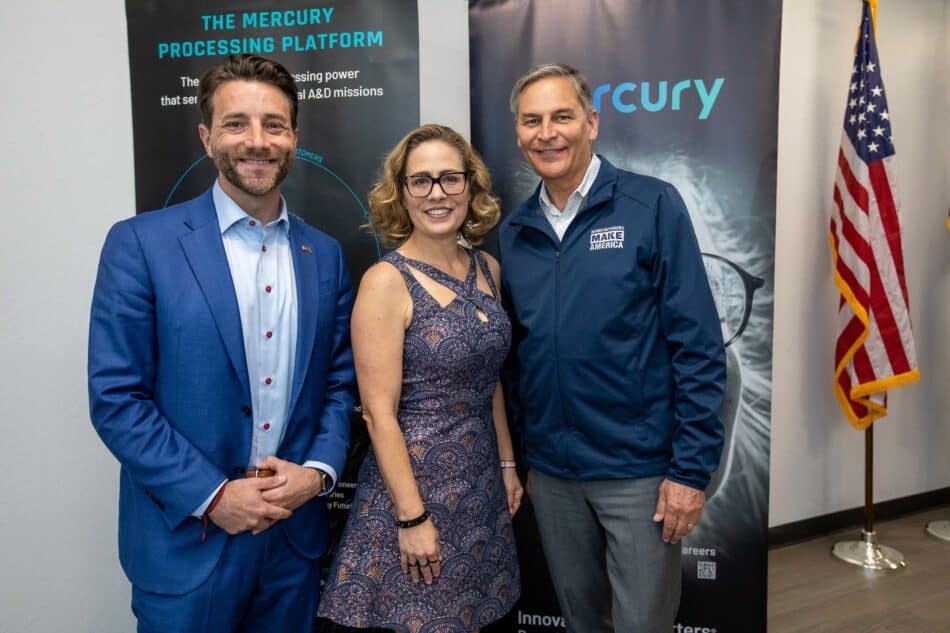
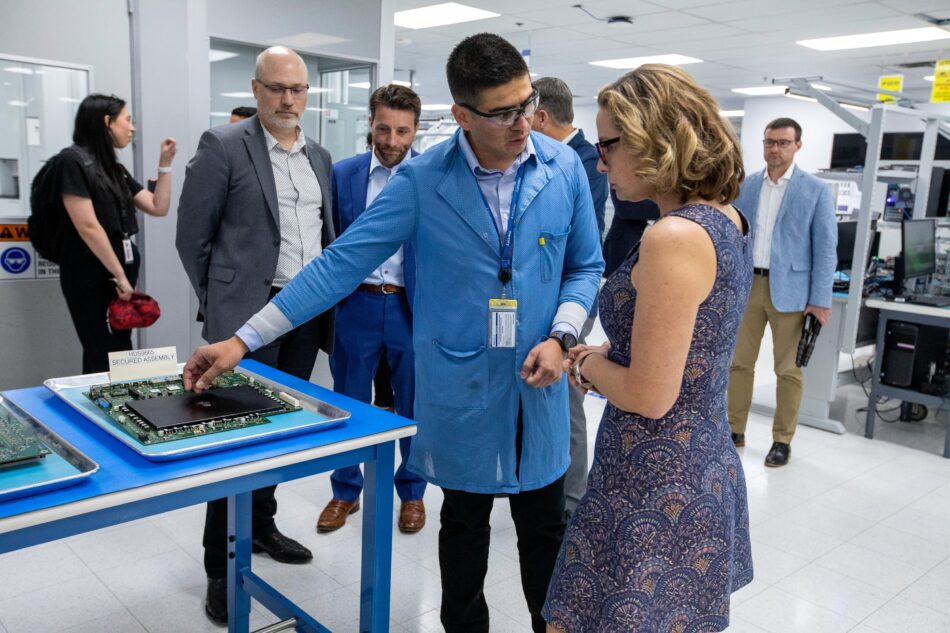
“The majority of Americans agree that the United States has a broken and unreliable immigration system, and our industry is united in the belief that this broken system is harming manufacturers’ competitiveness. With nearly 700,000 open jobs in manufacturing today and millions to fill this decade, immigration must be part of the solution,” said Timmons. “We must stay true to the values that have made America exceptional and kept manufacturing strong: free enterprise, competitiveness, individual liberty and equal opportunity, and that requires a functioning immigration system that addresses our economy’s needs, as well as security and humanitarian concerns. Today’s discussion is an important step in the path toward building consensus for advancing immigration reforms, and we thank the Arizona Chamber of Commerce & Industry and Sen. Sinema for their leadership.”
“Arizona has emerged as a premier destination for manufacturing growth, thanks to the pro-business policies we’ve implemented on a state level that have cut regulations and created an attractive tax environment for job creators to locate and expand,” said Chamber President and CEO Danny Seiden. “Of course, there is so much to be done at the federal level to ensure the continued competitiveness and success of our state and nation’s manufacturing industry – and immigration and workforce must be a part of the discussion. We are grateful for the partnership and leadership of Sen. Sinema and NAM in addressing this critical issue.”
“Mercury was delighted to host Sen. Sinema and global technology manufacturing leaders for this important conversation,” said Tom Smelker, Mercury Systems’ vice president and general manager of microsystems. “The vast majority of advanced semiconductor packaging is done in southeast Asia today, and the United States recognizes the need for more secure domestic capacity. But our skilled labor workforce is constrained, and we need a faster path to bring in more talent.”
Background: The NAM’s immigration policy recommendations are outlined in “A Way Forward,” a plan originally released in 2019 and recently updated to reflect current challenges. The NAM’s “A Way Forward” proposal identifies seven core areas of action for Congress and the administration to take:
- Strengthen border security through physical infrastructure and best-in-class technology.
- Prioritize America’s workforce needs through reforms to the legal immigration system.
- Reform nonimmigrant visas and temporary worker programs to reflect employer needs, including a fund to support STEM programs so that we can reduce the need for these types of visas in the future.
- Provide a permanent and compassionate solution for populations facing uncertainty, including the Dreamers, who were brought here as children and know no other home.
- Reform asylum and refugee programs for a more orderly and humane system, including asylum standards consistent with our values.
- Fix the problem of the unauthorized population with a firm reset, requiring an orderly process of review, including financial penalties for those who seek to become legal and deportation for those who choose to stay in the shadows.
- Strengthen the rule of law, with a focus on gang violence and on requiring localities to cooperate to advance the enforcement of immigration priorities.
-NAM-
The National Association of Manufacturers is the largest manufacturing association in the United States, representing small and large manufacturers in every industrial sector and in all 50 states. Manufacturing employs nearly 13 million men and women, contributes $2.90 trillion to the U.S. economy annually and accounts for 55% of private-sector research and development. The NAM is the powerful voice of the manufacturing community and the leading advocate for a policy agenda that helps manufacturers compete in the global economy and create jobs across the United States. For more information about the NAM or to follow us on Twitter and Facebook, please visit www.nam.org.
Women MAKE Awards Showcase Manufacturing Excellence
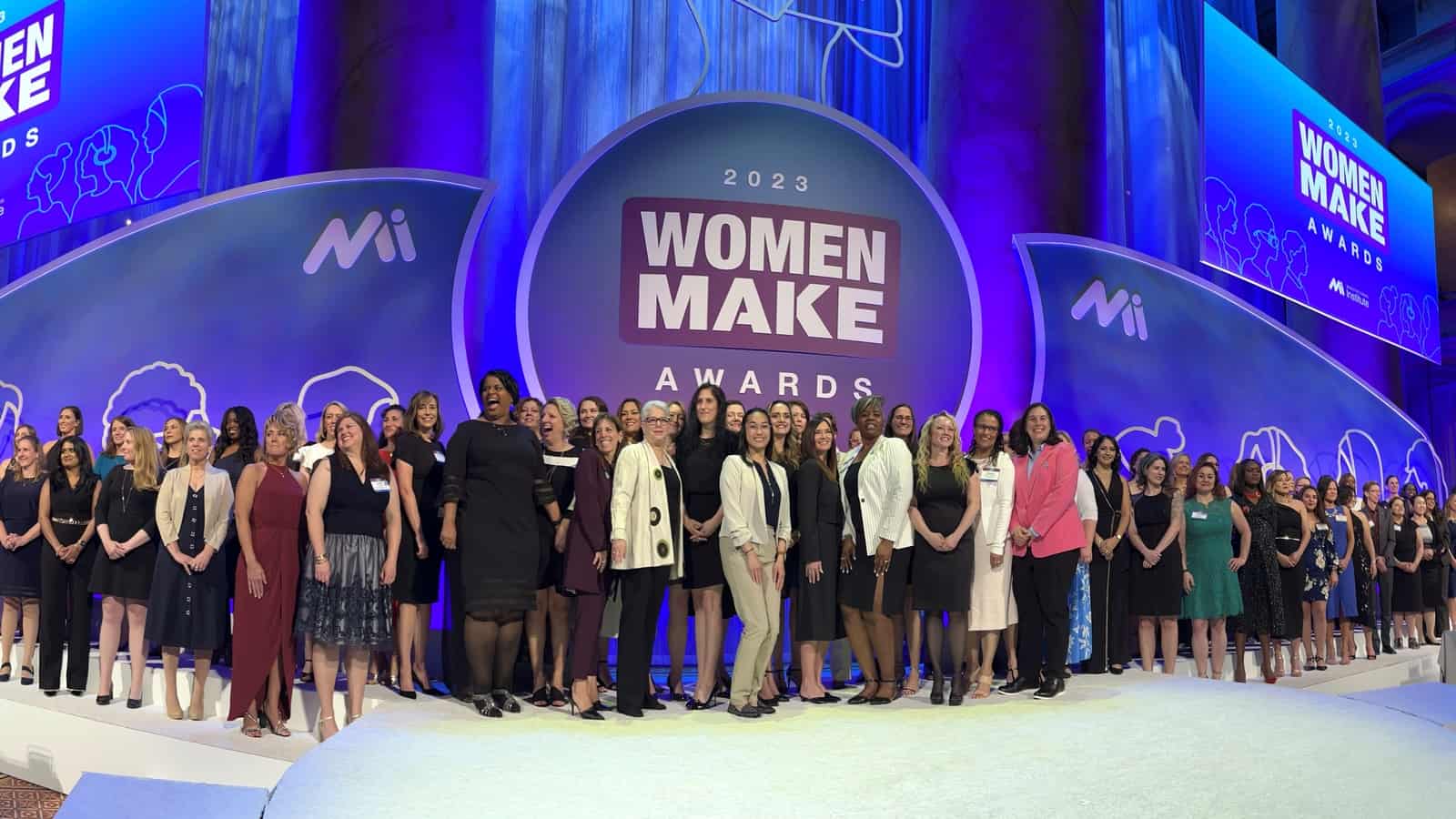
The energy and enthusiasm of the night were fittingly high for the occasion: a gala to honor 130 standout women in manufacturing.
What went on: The Manufacturing Institute’s 2023 Women MAKE Awards—formerly the STEP Ahead Awards—took place Thursday evening at the National Building Museum in Washington, D.C., following the two-day Women MAKE Leadership Conference. (The MI is the NAM’s 501(c)3 workforce development and education affiliate.)
- The gala—which featured a live performance by violinist Ezinma and was sponsored this year by BASF, Trane Technologies, Amazon and others—is held each year to honor women in manufacturing who exemplify leadership in their careers.
- This year the awards recognized 100 honorees and 30 “emerging leaders,” women under the age of 30 who have achieved unique accomplishments.
What was said: MI President and Executive Director Carolyn Lee delivered the night’s opening remarks, telling audience members she was humbled to be in their midst.
- “We have women who have launched entire product lines,” she said. “Women with dozens of patents to their name. Women who oversee the production and distribution of millions of products every day … women who constantly exceed expectations.”
- Carolyn Lee touched on the MI’s year-old 35×30 campaign, which aims to raise the percentage of women in manufacturing from 29% to 35% by 2030, and said the women honored at the gala serve as inspiration to young women considering manufacturing careers. “Because if you can see it, you can be it,” she said.
“The opportunity”: WMA Chair and Cornerstone Building Brands President and CEO Rose Lee underscored the importance of filling the current shortfall of manufacturing workers.
- If the shortage continues unchecked, the number of missing workers could exceed 2 million by 2030, she said, citing a study by the MI and Deloitte.
- “Therein lies the opportunity to engage an untapped, underutilized pool of women talent in the vitally important manufacturing sector,” Lee continued. “This is the collective work we need to pursue, and the honorees and emerging leaders here tonight are advancing this work by demonstrating the myriad ways in which women can achieve professional success in the manufacturing industry.”
Thank you: MI Board Chair and NAM President and CEO Jay Timmons thanked the honorees for showing the next generation what’s possible.
- “Thank you for being role models—including for my daughters and my son, the many families we have in this room and the people you impact every day,” Timmons said. “The ripple effect you can have is incalculable.”
From one to many: Rounding out the night’s lineup was event Vice Chair and Caterpillar Inc. Group President of Resource Industries Denise Johnson, who told the audience it was “remarkable” to be in a room with so many other women in manufacturing.
- “There have been many times throughout my career when I’ve been the only woman in a room, the only woman on a project,” she said. “What an incredible change of pace this is. I … am overwhelmed with gratitude and pride for how far we’ve come. Congratulations to all of you.”
Cornerstone Building Brands’ Rose Lee on Leadership in Manufacturing
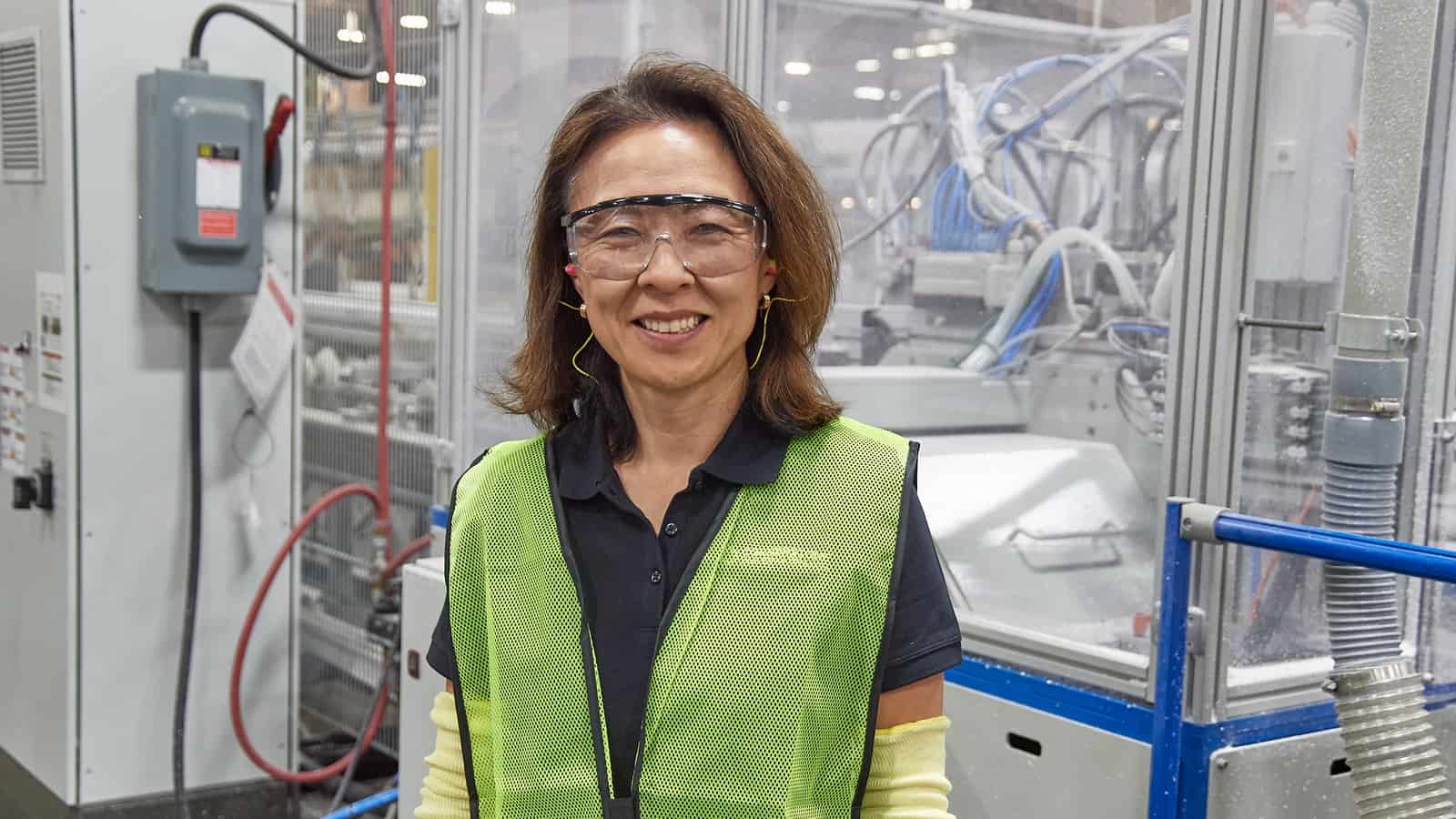
“It is up to us to shape our future,” Rose Lee advises women in manufacturing.
Women should “take the opportunity to lead and do it in your own way with the outcomes you know you’ll be able to produce so others will see you as an example of diversity,” continued the President and CEO of North Carolina–based Cornerstone Building Brands and member of the NAM Executive Committee. “There is not just one way of doing it, even in the manufacturing environment.”
This year, Lee is serving as chair of the Manufacturing Institute’s Women MAKE Awards, which will honor more than 100 outstanding women working in the industry. We spoke to Lee ahead of the awards ceremony, and here’s what she had to say.
Finding your passion: Lee describes herself as someone who derives a lot of satisfaction from the work she does—and wants to ensure others can do the same.
- “In our company, we are part of creating things that are part of the most important things in your life: your home, your shelter,” said Lee, who holds degrees in aeronautical and mechanical engineering as well as an M.B.A. “I find that very meaningful.”
- But her focus extends beyond the tangible, too. “There’s the content of what is done, but then there’s the opportunity that can be created for others … [which] increases the probability that they can find passion and enjoyment … like I had the opportunity to do.”
Increasing diversity: When it comes to diversifying the job pipeline in manufacturing, candidates themselves can often play a bigger role in their own success than they may realize, Lee said.
- “It starts with awareness that there are these opportunities. Then, [candidates should seek] the training, exposure and knowledge that are critical for these roles.”
- Meanwhile, “those of us who have the opportunity [must] make our voices louder,” she added. “Reach out to help people understand more clearly what is required and how you can advance yourself.”
- “We should all think about what more we can do ourselves and what more we can do together to welcome more women into manufacturing.” she continued.
Workplace flexibility: The same goes for manufacturers seeking to increase the number of women in their workforce, Lee added.
- “There is no magic solution,” Lee said. “But it’s important for companies and organizations to have a supportive structure, whether by providing [varied] job content, time off or additional flexibility in the work environment that [allows women to] balance things better.”
- “Supporting great initiatives that prioritize recognition, mentoring, education, skills training and networking are powerful ways to build a much stronger pipeline of women in manufacturing.”
Letting it go: Lee also knows a lot about having a rewarding career in manufacturing while being a caregiver at home—because she’s learned it firsthand.
- “Just remember that you can’t be everything to everybody all the time,” said Lee, a mother of two daughters. “It’s OK; let it go. Your kid doesn’t have to look like they’re in their Sunday best all the time.”
- Nor does the parenting style or career path that works for someone else have to work for you, she added. “You’ve got to design [being a working parent] so it’s bespoke to your life.”
Making history: Last year, when Honeywell International added her to its board of directors, Lee became the first Korean American woman to sit on the board of a Fortune 100 company. She regards the position as an opportunity to accomplish even more.
- “The building materials space doesn’t live in isolation,” Lee said. “Having a connection to a broader space, under global dynamics, helps [create] connectivity. We are continually deepening our knowledge.”
How Manufacturers Can Recruit Effectively

With 9.9 million job openings in the economy and 5.7 million people looking for jobs, the labor market is tight, with only 58 job seekers for every 100 job openings. Manufacturers who are looking to fill almost 700,000 jobs are struggling to find talent. That’s why the Manufacturing Institute convened a group of manufacturers last month for the Solution Series: Recruitment Workshop, where they discussed recruitment challenges and identified ways to address them. Here are some of the takeaways.
A wide range of challenges: At the beginning of the workshop, participants brought up the challenges they face in recruiting employees, particularly hourly and shop-floor workers.
- The most commonly cited challenge was communicating company culture and brand messaging. Several manufacturers in attendance had multiple locations with different cultures, which made it difficult to create consistent job postings. Meanwhile, other companies did not have a defined mission or set of values that they could easily promote to prospective employees.
- As one participant put it, “It’s important to think through why working at your company is good. This is different than the reasons why buying from the company is good.”
- Other challenges that participants shared included determining the right compensation in a competitive labor market, educating upper management on the changing economic landscape and attracting a wide array of candidates.
Food for thought: Participants then listened to industry experts speak about manufacturing employment trends, fair chance hiring, the gig economy and the importance of speed in recruitment.
- Employment trends: Manufacturers are competing against other manufacturers and industries for the same, limited labor pool, noted Chad Moutray, the director of the MI’s Center for Manufacturing Research and the NAM’s chief economist. “Issues like company culture, flexibility and career advancement become critical differentiators in a tight labor market,” he advised.
- Fair chance hiring: As Cassi Zumbiel, managing director at Envoy, put it, “Many of the barriers keeping second chance workers [individuals with criminal records] from good jobs were instituted by employers when the labor market was dramatically different, when there was a surplus of labor. That’s not the case anymore. Fair chance hiring can help address the labor shortage.”
- Gig workers: Wes Wood, director of strategic growth at Veryable, shared how his company’s online application connects gig workers to manufacturing jobs, filling in gaps in second and third shifts and having a positive impact on company culture.
- Recruitment: With manufacturers facing stiff competition for talent, moving quickly in the recruitment process makes a difference. Mike Schaefer, senior vice president at FactoryFix, described how his company supports manufacturers by automating follow-up within 15 minutes of a job seeker submitting an application.
Time to brainstorm: Participants also broke out into small groups to discuss their top challenges and brainstorm solutions. Here were some of their recommendations:
- Tighten up the job description. Think of a job description as an advertisement—not a contract. Keep it short. As one participant put it, “You don’t want to advertise accountability.” Another good tip: An external job description should not be the same as the internal job description. Only the latter should include all the details and technicalities.
- Streamline the application process. Don’t require a resume or cover letter for most of your hourly or entry-level positions. Ask only the key questions and reserve more in-depth ones for the phone screen or interview. One company cut its process down from 12 minutes to 3—and started receiving significantly more applications.
- Think about how to source talent. Consider working with K–12 schools, vocational programs and community colleges, or consider creating a second chance program, veterans program or refugee program. Lots of great talent pools exist. Manufacturers should explore their local options, find community partners and conduct consistent outreach.
The last word: After a day of energizing conversations, participants left ready to implement what they had learned. As one attendee put it, “Hearing what works and doesn’t work for other manufacturers was absolutely amazing.”
A FAME Student Finds His Place at Electrolux Group
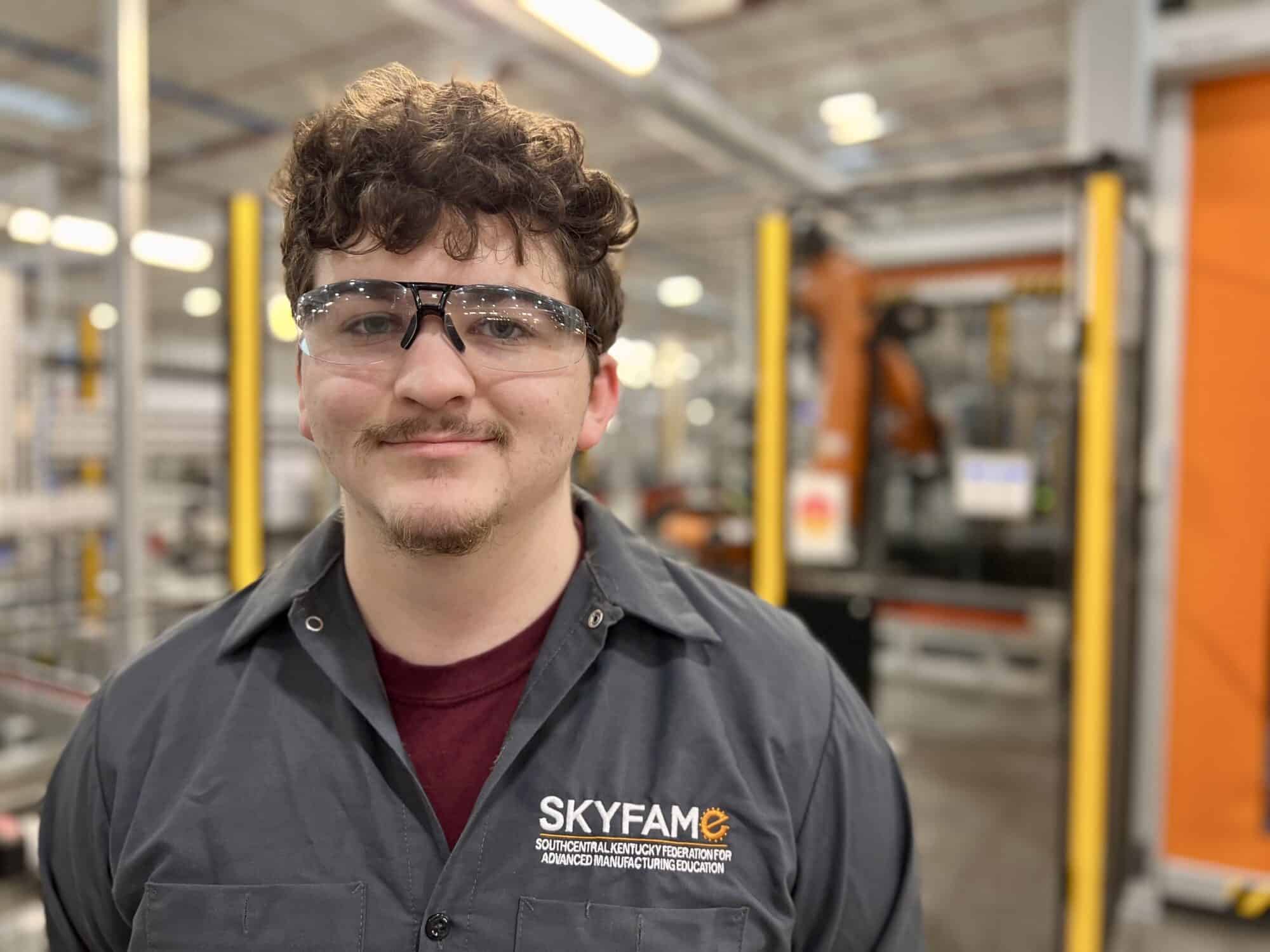
From the first moment Caleb Cleveland visited Electrolux Group—a home products and appliance manufacturer in Springfield, Tennessee—he knew it was the place for him.
“I knew I wanted to work with my hands,” said Cleveland. “I didn’t want to be sitting at a desk in front of a computer screen. I loved this place from day one.”
Cleveland found Electrolux Group through the Federation for Advanced Manufacturing Education program, or FAME, which his guidance counselor recommended to him. Today, both he and his employer are thrilled he’s taking part.
The program: Founded in 2010 by Toyota and operated today by The Manufacturing Institute, FAME aims to help students become highly skilled, sought-after workers capable of meeting the unique needs and challenges of the modern manufacturing sector.
- It provides current and aspiring workers with on-the-job training and classroom education, leading to an associate degree and the FAME advanced manufacturing technician certificate.
- “This program is one of a kind,” said Cleveland. “I’m actually getting paid to go to school. I’m getting the classroom and training classes here at Electrolux Group. I’m learning from people at school and from experts here.”
The benefits: At a time when manufacturers are struggling with record high job openings and a lack of skilled workers, FAME is helping to bring in a new generation of employees.
- Cleveland will be the Electrolux Group’s first graduate of the program when he completes it in May 2024, and the company sees his success as both a point of pride and an investment in the future of manufacturing.
- “We are committed to continuous upskilling of our current workforce and this is a strong pipeline for new talent with digital skills,” said Electrolux Group Senior Manager of Learning Dan Caldwell. “Part of our strategy is to partner with the FAME program so we can not only bring in Caleb with his classroom knowledge, but also help him to learn and grow.”
Changing minds: FAME is also helping to improve perceptions of the manufacturing industry among young people.
- “In the past, manufacturing has had a dark and gloomy reputation, and we are changing that perspective,” said Electrolux Technical Trainer Eric Drake. “We want up-and-coming talent to know that there are people in manufacturing who care about their future and want them to succeed. We’ll provide the stepping stones for their journey.”
Off to a great start: According to Caldwell and Drake, Cleveland has been an enormous asset for the company already.
- By the end of his first semester, he was able to step in and do most of the work of a process technician, filling in at a time when the company was shorthanded.
- “Caleb is doing a knockout job,” said Drake. “Our objective is to make opportunities available for him.” Caldwell added, “We are incredibly proud of Caleb with the initiative he takes.”
The bottom line: “The program has exceeded my expectations,” said Cleveland. “When I first started I was worried about being seen as that intern who sticks to somebody’s hip. But at Electrolux Group, I found my own place.”
A GM Engineer Follows in Her Parents’ Footsteps
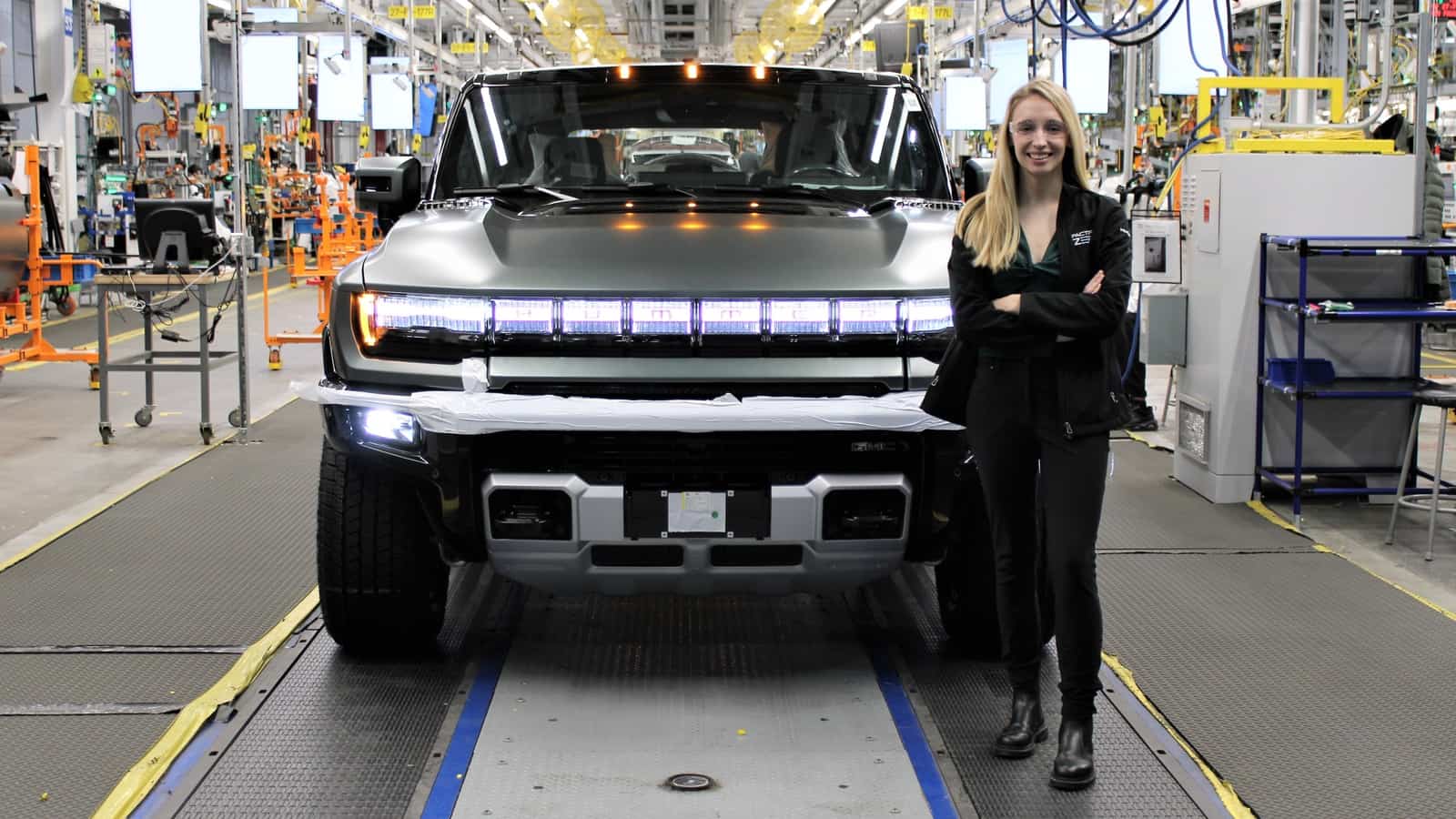
Alison Holland was almost predestined to be an engineer at General Motors. Born to an electrical engineer mother and a mechanical engineer father, both of whom work at GM, she grew up entirely familiar with the discipline and the company.
Today, she’s working to establish GM’s first-ever assembly operations for a new EV battery platform at Factory ZERO in Detroit-Hamtramck, Michigan. Recently named an Emerging Leader by the Manufacturing Institute’s 2023 Women MAKE Awards, which honor outstanding women in the industry, Holland spoke to us about her career, her work helping other young women find their footing and her goals for the future.
Not your mother’s industry: As the daughter of a female engineer, Holland has a unique perspective on the role of women in the industry. How was her mother’s experience different from her own?
- Women were much more in the minority back then, Holland said, and her mother “had to work even harder to earn her way to the top.”
- Holland learned a great deal about managing her own career from her mother, a kind, patient parent who never missed her four children’s activities or let the pressures of work invade her home life.
Choosing manufacturing: While her parents’ example set her on the path toward manufacturing, Holland also attributes her comfort in the industry to her competitive nature.
- The former college soccer player says manufacturing has a similar feel to sports and is rewarding for those who want to excel in a “high-paced” environment.
- “I wanted a career where I could be challenged and see my efforts pay off with real-time results”—just as she did on the field.
A sustainable career: At GM, Holland is part of an exciting project: launching GM’s first battery assembly plant under the same roof as EV truck assembly at Factory ZERO. The battery, or Rechargeable Energy Storage System, is based on GM’s Ultium battery platform, which will increase the range, power and performance of a number of different vehicle types. She works with coordinators and engineers at different sites, making sure best practices are codified and shared throughout the company.
- Holland loves her work because “it’s a new challenge every day. I’m helping to reinvent the wheel when it comes to battery production. The small decisions we make will have a long-lasting impact.”
A young leader: Holland considers herself lucky to have had excellent female mentors, who helped her learn to “make her opinions heard.” Today, she helps other people, including many women, find support for their own goals.
- As part of GM’s early career development program for manufacturing engineers, Holland organized events like lunch-and-learns so that young workers could hone their professional skills together and build productive relationships. She also helped participants find and benefit from mentors who previously went through the program.
- Holland also provides coaching to women who are experiencing professional “firsts”—such as the first time they work on the production line, or encounter a new process, or lead teammates with unique backgrounds. Holland began this work while serving as a mentor in the early career development program and has kept it up as she leads her own team.
What’s next? When Holland looks ahead, all she sees are opportunities. “I am super interested in sustainability. I want more experience in other production departments, so I can understand all the other sides of the business. I want to have more cross-functional experiences, so I can better understand what people are asking of me.”
The last word: Holland has simple but important advice for young women starting out in the industry. “Learn as much as you can. Take any opportunity to learn about the industry. That will boost your confidence. It takes some time and you’ll make some mistakes, but all of those experiences matter.”
A One-Woman Workforce Solution: Meet Toyotetsu’s Leslie Cantu

Leslie Cantu has an unusual but effective method of stress reduction: cuddling with bovines.
“You can’t stay stressed or frustrated when you have a cow licking you on the cheek,” laughed Toyotetsu’s assistant vice president of administration.
Ranch life: Living on a ranch south of San Antonio, Texas, with 13 dogs, 15 cats, five miniature horses, multiple sheep and three newborn lambs might sound to others like a lot of work, but to Cantu, it is indeed a method of decompression.
- “I have five children and two grandbabies, and spending time with them out on the ranch, just being able to take care of the animals and enjoy time with the kids, it’s rewarding, it’s relaxing,” said Cantu.
- Life on the ranch sounds busy, but it’s nothing compared to work life for Cantu, a 2023 Honoree of the Manufacturing Institute’s Women MAKE Awards, which recognize top female talent in the manufacturing industry. She’s involved in a dizzying array of workforce programs both at the company and outside of it.
Finding FAME: Cantu, the first woman to be named an assistant vice president at the global automotive parts manufacturer, spends a lot of time making a difference for the company’s workforce.
- In 2016, her first year on the job, she helped Toyotetsu open the Federation for Advanced Manufacturing Education’s first Texas chapter, TX FAME – Alamo. Today, she serves as the chapter president.
- “Through FAME, we’ve really been able to build that multiskilled-technician pipeline to make sure we can meet those critical skills needed for our business,” Cantu said of the workforce development initiative for high school graduates, which was founded by Toyota and is now operated by the MI (the NAM’s 501(c)3 workforce development and education affiliate).
Seeking diversity: Cantu also helped Toyotetsu form a partnership with the Texas Workforce Commission and the local workforce development board to create a 12-week manufacturing apprenticeship program—the first of its kind in Texas—for individuals with disabilities. The inaugural class graduated in January.
- “It’s programs like this and FAME that help us find unique ways to fill those skills gaps and focus on diversifying the workforce,” she said. “There’s a lot to be said for diversifying the workforce, [including] improved morale and retention.”
A second chance: In 2018, in another bid to deepen Toyotetsu’s talent pool, Cantu spearheaded the launch of a second chance hiring initiative in partnership with the local county’s economic development board. The project now consists of seven manufacturers, all of whom regularly hire formerly incarcerated individuals—with great results.
- “Toyotetsu alone has hired about 140 ex-offenders and had tremendous success with that,” said Cantu.
- “Analyzing our data and metrics, we’ve been able to see that our second chance population has better performance and better retention than those who come to us through traditional recruiting. [Second chance] has effectively become a go-to, best practices strategy for us.”
Playing to strengths: Cantu credits some of her success in strengthening Toyotetsu’s workforce to her natural ability to think creatively.
- “As we continue to work through the national skills-force gap, hiring and COVID-19, it’s become important to think outside the box … to see how we could build our talent pipeline,” Cantu said.
- “That’s one of my strengths, tapping into those resources. Part of that is knowing what resources are out there, and thankfully, I’ve got a great boss and corporate office that support community involvement,” she added.
And if that wasn’t enough … Cantu is the chair of Workforce Solutions Alamo, and she sits on the board of the Texas Workforce Commission’s Adult Education & Literacy Advisory Committee and on the advisory board of a local high school.
The last word: Cantu has some encouraging words for women looking to follow in her (very energetic) footsteps:
- “Oftentimes there’s an image of manufacturing [as being] for men, or [that] it’s dark, it’s dirty, it’s dangerous. And that’s not what manufacturing is. There’s a lot of opportunity to use the skills that women bring to the table: multitasking, transferable skills,” she says.
- “It’s incredibly important that we mentor women thinking about careers in manufacturing, tell our stories and share the journey so that we can encourage others following the same path.”
A Young Engineer Makes Herself Heard in Manufacturing
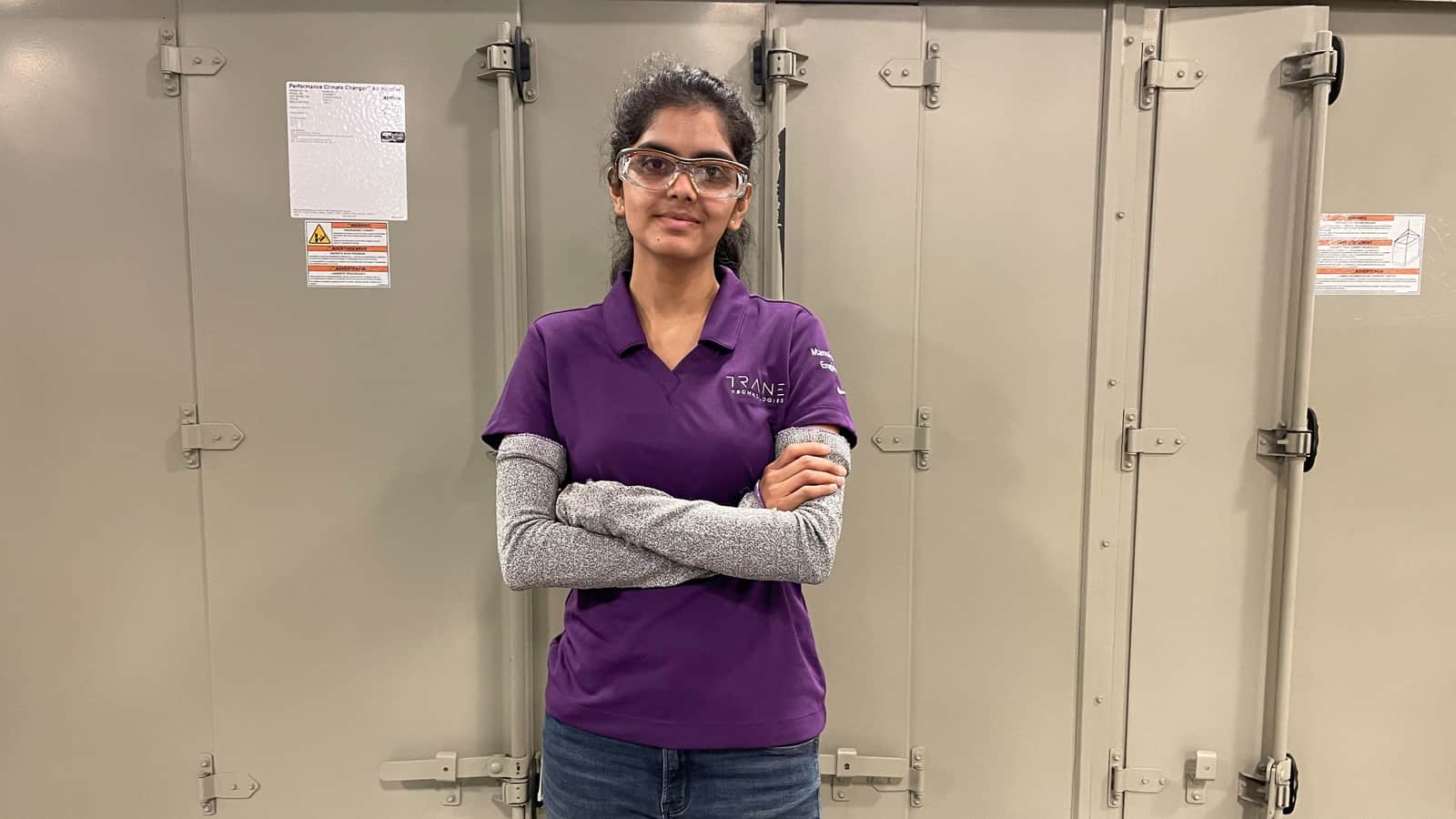
Rashmi Vadlakonda is a woman with a voice, and she’s not afraid to use it.
As a manufacturing engineer at Trane Technologies—a company focused on sustainable climate innovations—Vadlakonda is making advancements in engineering and paving the way for more women of color to join her. That’s why she was recently recognized by the Manufacturing Institute’s 2023 Women MAKE Awards as an Emerging Leader.
The award: The Women MAKE Awards, formerly known as the STEP Ahead Awards, honor top female talent in the industry while providing honorees with a platform to inspire other future industry leaders. Vadlakonda sees the honor as an opportunity to keep speaking up for people who are underrepresented.
- “I believe that for young women in manufacturing, especially for me as an immigrant young woman of color … a title helps,” said Vadlakonda. “This award gives me that title [and] the courage that I need to speak up and say, ‘Hey, I have something to share, and I want you to listen to me. There’s a reason I was recognized.’”
Starting out: Vadlakonda wasn’t immediately drawn to engineering, but when she was growing up in India, it was typical for young people to pursue engineering or medicine.
- Once she “fell into it,” she loved it, and took an especially strong interest in 3D printing while in graduate school at North Carolina State University. Her passion for 3D printing is what brought her to Trane Technologies.
Making the transition: When she first came to the company, she was responsible for operationalizing additive manufacturing throughout the company.
- She spent a few years in a corporate setting, traveling to different offices and introducing advanced manufacturing technologies—but when the pandemic hit and travel was largely suspended, she had plenty of time to think about what she wanted to do next. That’s when she decided to pivot to working in a factory setting.
- “The factory is a basic building block of the manufacturing industry,” said Vadlakonda. “Coming from a research background, I wanted to understand how a factory functions, how the people there think, how different groups interact with each other, and what it takes to actually deliver a good product.”
The factory floor: Vadlakonda is grateful she got a chance to work in both the corporate and factory environments. In a factory, she says, the pace is much faster, and you’re pushed to solve problems right in front of you. This was a challenge she found thrilling.
To women in the industry: When asked what her advice is for women in the industry, Vadlakonda first had advice for industry leaders. She believes they must create a comfortable environment for people from all walks of life.
- “Sure, you can get someone interested in manufacturing, you can help them come into the industry,” said Vadlakonda. “But we also have the responsibility of creating a welcoming environment where they feel like they can grow, so that they don’t leave, so that they’re happy here in the industry.”
The future: Vadlakonda, who is a champion of, and volunteer for, the industry’s Creators Wanted campaign to inspire the next generation of creators, believes it is vital that young people are exposed to manufacturing career options at an early age.
- “It doesn’t start with talking to women who have decided on a career path,” said Vadlakonda. “You have to start with kids. That’s why I like talking at Creators Wanted. Young people are naturally attracted to what they’re attracted to. Our job as adults is to help them see the options.”
The last word: “Manufacturing is very exciting,” said Vadlakonda. “It’s very interesting, you get to be creative and solve problems—and it’s such a satisfying feeling to solve problems.”
